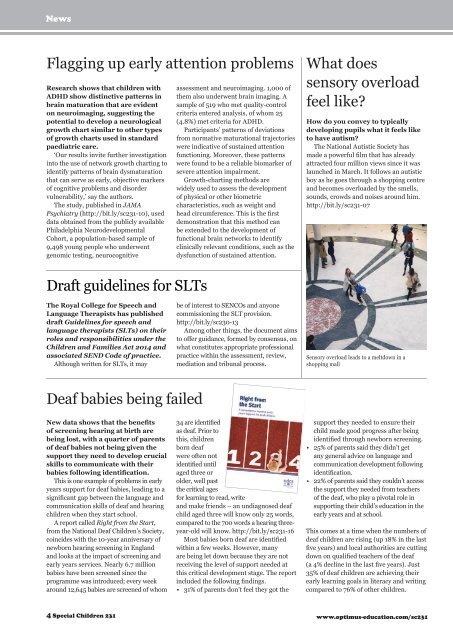champions
1H1C301qFr9
1H1C301qFr9
Create successful ePaper yourself
Turn your PDF publications into a flip-book with our unique Google optimized e-Paper software.
News<br />
Flagging up early attention problems<br />
Research shows that children with<br />
ADHD show distinctive patterns in<br />
brain maturation that are evident<br />
on neuroimaging, suggesting the<br />
potential to develop a neurological<br />
growth chart similar to other types<br />
of growth charts used in standard<br />
paediatric care.<br />
‘Our results invite further investigation<br />
into the use of network growth charting to<br />
identify patterns of brain dysmaturation<br />
that can serve as early, objective markers<br />
of cognitive problems and disorder<br />
vulnerability,’ say the authors.<br />
The study, published in JAMA<br />
Psychiatry (http://bit.ly/sc231-10), used<br />
data obtained from the publicly available<br />
Philadelphia Neurodevelopmental<br />
Cohort, a population-based sample of<br />
9,498 young people who underwent<br />
genomic testing, neurocognitive<br />
assessment and neuroimaging. 1,000 of<br />
them also underwent brain imaging. A<br />
sample of 519 who met quality-control<br />
criteria entered analysis, of whom 25<br />
(4.8%) met criteria for ADHD.<br />
Participants’ patterns of deviations<br />
from normative maturational trajectories<br />
were indicative of sustained attention<br />
functioning. Moreover, these patterns<br />
were found to be a reliable biomarker of<br />
severe attention impairment.<br />
Growth-charting methods are<br />
widely used to assess the development<br />
of physical or other biometric<br />
characteristics, such as weight and<br />
head circumference. This is the first<br />
demonstration that this method can<br />
be extended to the development of<br />
functional brain networks to identify<br />
clinically relevant conditions, such as the<br />
dysfunction of sustained attention.<br />
What does<br />
sensory overload<br />
feel like?<br />
How do you convey to typically<br />
developing pupils what it feels like<br />
to have autism?<br />
The National Autistic Society has<br />
made a powerful film that has already<br />
attracted four million views since it was<br />
launched in March. It follows an autistic<br />
boy as he goes through a shopping centre<br />
and becomes overloaded by the smells,<br />
sounds, crowds and noises around him.<br />
http://bit.ly/sc231-07<br />
Draft guidelines for SLTs<br />
The Royal College for Speech and<br />
Language Therapists has published<br />
draft Guidelines for speech and<br />
language therapists (SLTs) on their<br />
roles and responsibilities under the<br />
Children and Families Act 2014 and<br />
associated SEND Code of practice.<br />
Although written for SLTs, it may<br />
be of interest to SENCOs and anyone<br />
commissioning the SLT provision.<br />
http://bit.ly/sc230-13<br />
Among other things, the document aims<br />
to offer guidance, formed by consensus, on<br />
what constitutes appropriate professional<br />
practice within the assessment, review,<br />
mediation and tribunal process.<br />
Sensory overload leads to a meltdown in a<br />
shopping mall<br />
Deaf babies being failed<br />
New data shows that the benefits<br />
of screening hearing at birth are<br />
being lost, with a quarter of parents<br />
of deaf babies not being given the<br />
support they need to develop crucial<br />
skills to communicate with their<br />
babies following identification.<br />
This is one example of problems in early<br />
years support for deaf babies, leading to a<br />
significant gap between the language and<br />
communication skills of deaf and hearing<br />
children when they start school.<br />
A report called Right from the Start,<br />
from the National Deaf Children’s Society,<br />
coincides with the 10-year anniversary of<br />
newborn hearing screening in England<br />
and looks at the impact of screening and<br />
early years services. Nearly 6.7 million<br />
babies have been screened since the<br />
programme was introduced; every week<br />
around 12,645 babies are screened of whom<br />
34 are identified<br />
as deaf. Prior to<br />
this, children<br />
born deaf<br />
were often not<br />
identified until<br />
aged three or<br />
older, well past<br />
the critical ages<br />
for learning to read, write<br />
and make friends – an undiagnosed deaf<br />
child aged three will know only 25 words,<br />
compared to the 700 words a hearing threeyear-old<br />
will know. http://bit.ly/sc231-16<br />
Most babies born deaf are identified<br />
within a few weeks. However, many<br />
are being let down because they are not<br />
receiving the level of support needed at<br />
this critical development stage. The report<br />
included the following findings.<br />
• 31% of parents don’t feel they got the<br />
support they needed to ensure their<br />
child made good progress after being<br />
identified through newborn screening.<br />
• 25% of parents said they didn’t get<br />
any general advice on language and<br />
communication development following<br />
identification.<br />
• 22% of parents said they couldn’t access<br />
the support they needed from teachers<br />
of the deaf, who play a pivotal role in<br />
supporting their child’s education in the<br />
early years and at school.<br />
This comes at a time when the numbers of<br />
deaf children are rising (up 18% in the last<br />
five years) and local authorities are cutting<br />
down on qualified teachers of the deaf<br />
(a 4% decline in the last five years). Just<br />
35% of deaf children are achieving their<br />
early learning goals in literacy and writing<br />
compared to 76% of other children.<br />
4 Special Children 231<br />
www.optimus-education.com/sc231


